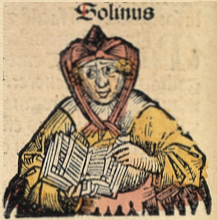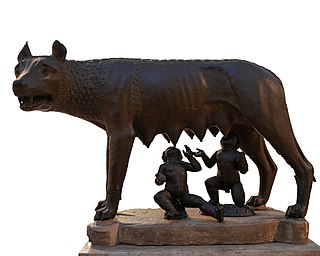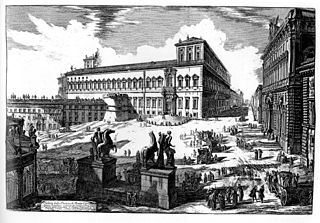Related Research Articles

Gaius Julius Solinus, better known simply as Solinus, was a Latin grammarian, geographer, and compiler who probably flourished in the early 3rd century AD. Historical scholar Theodor Mommsen dates him to the middle of the 3rd century.

The Campus Martius was a publicly owned area of ancient Rome about 2 square kilometres in extent. In the Middle Ages, it was the most populous area of Rome. The IV rione of Rome, Campo Marzio, which covers a smaller section of the original area, bears the same name.
Ranulf Higden or Higdon was an English chronicler and a Benedictine monk who wrote the Polychronicon, a Late Medieval magnum opus. Higden, who resided at the monastery of St. Werburgh in Chester, is believed to have been born in the West of England before taking his monastic vow at Benedictine Abbey in Chester in 1299. As a monk, he travelled throughout the North and Midlands of England, including Derbyshire, Shropshire and Lancashire.

The Forma Urbis Romae or Severan Marble Plan is a massive marble map of ancient Rome, created under the emperor Septimius Severus between 203 and 211 CE. Matteo Cadario gives specific years of 205–208, noting that the map was based on property records.

John Trevisa was a Cornish writer and professional translator.

The Basilica of Saint Mary of the Altar in Heaven is a titular basilica in Rome, located on the highest summit of the Campidoglio. It is still the designated church of the city council of Rome, which uses the ancient title of Senatus Populusque Romanus. The present cardinal priest of the Titulus Sanctae Mariae de Aracoeli is Salvatore De Giorgi.

As the home of the Pope and the Catholic curia, as well as the locus of many sites and relics of veneration related to apostles, saints and Christian martyrs, Rome had long been a destination for pilgrims. The Via Francigena was an ancient pilgrim route between England and Rome. It was customary to end the pilgrimage with a visit to the tombs of Saints Peter and Paul. Periodically, some were moved to travel to Rome for the spiritual benefits accrued during a Jubilee. These indulgences sometimes required a visit to a specific church or churches. Pilgrims need not visit each church.

Mirabilia Urbis Romae is a much-copied medieval Latin text that served generations of pilgrims and tourists as a guide to the city of Rome. The original, which was written by a canon of St Peter's, dates from the 1140s. The text survives in numerous manuscripts.

The Umbilicus Urbis Romae —"Navel of the City of Rome"—was the symbolic centre of the city, a reference point from which, and to which, all distances in Ancient Rome were measured. It was situated in the Roman Forum where its remnants can still be seen. These remains are located beside the Arch of Septimius Severus and the Vulcanal, behind the Rostra. Originally covered in marble, the Umbilicus is now a forlorn-looking brick core some 2 metres high and 4.45 metres in diameter.

The Temple of Antoninus and Faustina is an ancient Roman temple in Rome, which was later converted into a Roman Catholic church, the Chiesa di San Lorenzo in Miranda or simply "San Lorenzo in Miranda". It is located in the Forum Romanum, on the Via Sacra, opposite the Regia.

Boy with Thorn, also called Fedele (Fedelino) or Spinario, is a Greco-Roman Hellenistic bronze sculpture of a boy withdrawing a thorn from the sole of his foot, now in the Palazzo dei Conservatori, Rome. There is a Roman marble version of this subject from the Medici collections in a corridor of the Uffizi Gallery, Florence.

The Capitoline Wolf is a bronze sculpture depicting a scene from the legend of the founding of Rome. The sculpture shows a she-wolf suckling the mythical twin founders of Rome, Romulus and Remus. According to the legend, when King Numitor, grandfather of the twins, was overthrown by his brother Amulius in Alba Longa, the usurper ordered them to be cast into the Tiber River. They were rescued by a she-wolf that cared for them until a herdsman, Faustulus, found and raised them.

The colossal pair of marble "Horse Tamers"—often identified as Castor and Pollux—have stood since antiquity near the site of the Baths of Constantine on the Quirinal Hill, Rome. Napoleon's agents wanted to include them among the classical booty removed from Rome after the 1797 Treaty of Tolentino, but they were too large to be buried or to be moved very far. They are fourth-century Roman copies of Greek originals. They gave to the Quirinal its medieval name Monte Cavallo, which lingered into the nineteenth century. Their coarseness has been noted, while the vigor—notably that of the horses—has been admired. The Colossi of the Quirinal are the original exponents of this theme of dominating power, which has appealed to powerful patrons since the seventeenth century, from Marly-le-Roi to Saint Petersburg.

The Arch of Augustus was the triumphal arch of Augustus, located in the Roman Forum. It spanned the Via Sacra, between the Temple of Castor and Pollux and the Temple of Caesar, near the Temple of Vesta, closing off the eastern end of the Forum. It can be regarded as the first permanent three-bayed arch ever built in Rome.
Parastaseis syntomoi chronikai is an eighth- to ninth-century Byzantine text that concentrates on brief commentary connected to the topography of Constantinople and its monuments, notably its Classical Greek sculpture, for which it has been mined by art historians.

The Pons Neronianus or Bridge of Nero was an ancient bridge in Rome built during the reign of the emperors Caligula or Nero to connect the western part of the Campus Martius with the Ager Vaticanus, where the Imperial Family owned land along the Via Cornelia.
Francesco Albertini was a canon of the Basilica of San Lorenzo in Florence and a chaplain of Cardinal Fazio Santoro in Rome. In 1510 he wrote three books: The Opusculum de mirabilibus novae & veteris urbis Romae, the Septem mirabilia orbis et urbis Romae et Florentinae and the Memoriale di molte picture e statue sono nella inclyta cipta di Florentia.

The topography of ancient Rome is the description of the built environment of the city of ancient Rome. It is a multidisciplinary field of study that draws on archaeology, epigraphy, cartography and philology. The word 'topography' here has its older sense of a description of a place, now often considered to be local history, rather than its usual modern meaning, the study of landforms.
The Arch of Scipio was an ancient Roman arch located atop the Capitoline Hill.
References
- Higden, Ranulph: Polychronicon Ranulphi Higden monachi Cestrensis; together with the English translation of John Trevisa and of an unknown writer of the fifteenth century. Edited by Churchill Babington and Joseph Rawson Lumby. (The Chronicles and Memorials of Great Britain and Ireland during the Middle Ages, 41. Vol. 3-9) London, 1865-86.
- Hildebertus Cenomannensis Episcopus: Carmina minora, recensuit A. Brian Scott. (Bibliotheca scriptorum Graecorum et Romanorum Teubneriana) Monachii: K. G. Saur, 2001 ( ISBN 3-598-71984-1)
- James, M.R.: "Magister Gregorius de mirabilibus urbis Romae" in The English Historical Review , 32 No. 128 (October 1917), pp. 531-554
- The Marvels of Rome, trans. John Osborne (Toronto: Pontifical Institute, 1987)
- Panofsky, Erwin: Renaissance and Renascences in Western Art. (Figura, 10). Stockholm: Almqvist & Wiksell, 1960.
- Ross, James Bruce: "A Study of twelfth-century interest in the antiquities of Rome", in: Medieval and Historiographical Studies in Honor of J.W. Thompson, Chicago 1938, pp. 302-321.
- Rushforth, G. McN.: "Magister Gregorius de mirabilibus urbis Romae", Journal of Roman Studies 9 (1919), pp. [14]-58.